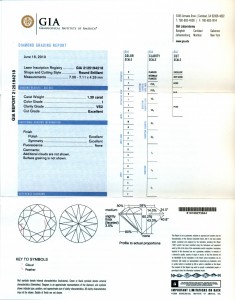WEBSITE HIGHLIGHTS: APPRAISER DIRECTORY
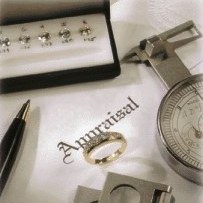 As a service to our clients across the country, we are compiling a directory of independent appraisers. Our clients referred these appraisers after using their services. Keep in mind that these appraisers do more than just inspect diamonds. They can evaluate all types of jewelry, which is important if you have inherited items or just need to get a current insurance appraisal to keep up with the price increases in diamonds, gold and platinum.
As a service to our clients across the country, we are compiling a directory of independent appraisers. Our clients referred these appraisers after using their services. Keep in mind that these appraisers do more than just inspect diamonds. They can evaluate all types of jewelry, which is important if you have inherited items or just need to get a current insurance appraisal to keep up with the price increases in diamonds, gold and platinum.
Check to see if there is an appraiser near you
DIAMOND SHOPPER MISTAKES: BEWARE OF THE LIGHTS
 Beware of the lights! The beauty of diamonds is a result of how this unique stone handles light that passes through and reflects back to the viewer eyes. When shopping for diamonds, be alert to the lighting conditions because they can influence the appearance of the diamond as much as the diamond itself.
Beware of the lights! The beauty of diamonds is a result of how this unique stone handles light that passes through and reflects back to the viewer eyes. When shopping for diamonds, be alert to the lighting conditions because they can influence the appearance of the diamond as much as the diamond itself.
One of the tricks in a jewelry store is the expensive lighting systems utilized to maximize the sparkle of everything in and viewed on their display cases. The special white lights are designed to make diamonds appear white and bright and the small spotlights and LED strips produce extraordinary sparkle and fire. In fact, you can put a piece of broken glass in or on a jewelry display case and it will dazzle the eyes with sparkle. Unfortunately, you cannot take the store lighting system home with you and many of those pieces of jewelry are dull and lifeless, just like the piece of broken glass.
What should a diamond shopper do about light? The key is to examine a diamond in as many types of light as possible so they will know what it will look like in every day life. Since most offices, kitchens and public areas have fluorescent lighting, be sure to view the diamond in this diffused light, which produces little sparkle but shows off the brightness of the diamond. Fluorescent light bulbs have different levels of whiteness so do not be surprised if some diamonds appear slightly yellow in one room but whiter in another. Incandescent light bulbs produce a different look for the diamond as it shows off the sparkle and fire.
Direct sunlight produces almost blinding fire in a diamond but tends to make it look dark because the sun is so strong it is hard to see the brilliance of the facets. If the sky is blue, the diamond will look blue. If the sky is cloudy, the diamond will take on a grayish hue.
In the real world, most social gatherings are in relatively soft lighting light such as occur in restaurants or living rooms. So examine your diamond in these low light conditions too because you will spend more hours there with your diamond than under a spotlight in a jewelry store. If the diamond looks great in all types of lighting, you have a winner.
GIA DIAMOND GRADING REPORT CHECK
![]() In an effort to provide assurance to the diamond industry and consumers that the information on their grading report matches the data in the GIA report database, the GIA now provides an online report check service.
In an effort to provide assurance to the diamond industry and consumers that the information on their grading report matches the data in the GIA report database, the GIA now provides an online report check service.
The service is currently available for GIA Diamond Grading Reports and GIA Diamond Dossier documents issued after January 1, 2000.
This service is a response to concerns there are some counterfeit GIA Diamond Grading Reports in circulation. The GIA goes to great lengths to include security measures in the grading reports including a hologram, security screen, microprint lines, chemically sensitive paper and other proprietary security components. Still, the high dollar value of large diamonds brings out skilled counterfeiters that alter reports or publish their own.
Another deceitful practice is the deliberate mismatching of a grading report with a different diamond with similar measurements and slightly different grades. On large diamonds, the differences in a color and clarity grade can be tens of thousands of dollars. These mismatched grading reports are meant to deceive buyers who might not examine the diamond in sufficient detail to identify that the diamond does not match the grading report. Often diamonds are quickly identified by carat weight and a few measurements with a millimeter gauge because a more in-depth examination requires a microscope and considerably more time and knowledge.
While the occurrences of mismatching or counterfeit grading reports is very rare, any circumstance that puts doubt in the mind of the diamond shopper is very detrimental to the diamond industry as a whole. The GIA makes every effort to maintain the highest standards of reliability, consistency and integrity.
The following is a link to the GIA webpage that allows entry of a Report Number and Carat Weight. With that information, you can retrieve a summary of the information on that GIA grading report.
GIA CHANGES DIAMOND REPORT FORMATS
Beginning in January 2006, the Gemological Institute of America (GIA) changed the format of their Diamond Grading Reports and their Diamond Dossier. This change coincided with the introduction of the new GIA cut grading system that will be discussed in more detail in the next issue of the Diamond Source of Virginia Newsletter.
CLICKS AND STONES: DIAMOND RETAILERS
Kiplinger’s Personal Finance magazine (February 2006 issue) included an article entitled “Clicks & Stones” that discussed the value you can now get with online diamond retailers.
In an industry famous for high markups and perpetual closeout sales, diamond e-tailers have brought clarity and competition to pricing jewelry. Scott Devitt, a senior analyst at Legg Mason says, “They expose diamonds for the commodities they are.”
 E-tailers’ costs are lower than for local jewelers because they spend less on labor, leases, inventory, display cases, special lighting and all the other expenses that the diamond shopper can not wear out of the store. Because of the better values available with diamond e-tailers, the online retailers sold about $340 million in engagement ring sales in 2005. Since local jewelry store prices are often double those for online retailers, that equates to a lot of diamonds and the trend continues to increase.
E-tailers’ costs are lower than for local jewelers because they spend less on labor, leases, inventory, display cases, special lighting and all the other expenses that the diamond shopper can not wear out of the store. Because of the better values available with diamond e-tailers, the online retailers sold about $340 million in engagement ring sales in 2005. Since local jewelry store prices are often double those for online retailers, that equates to a lot of diamonds and the trend continues to increase.
The article mentions that the online diamond shopper’s biggest concern seems to be that you have to buy the diamond without seeing them in advance. At Diamond Source of Virginia, we agree that you should examine the diamond before paying for it. Our business is designed so our clients get to examine their diamond before purchasing.
An aid to diamond shoppers is that now the cut grade of the diamond is provided on the certifications. The AGS certifications have a cut grade and starting in January of this year, the GIA will start providing a cut grade for round diamonds. However, most shapes other than round brilliant diamonds do not currently have cut grades and getting a beautiful diamond is a little more complicated. The challenge for the typical diamond shoppers is how to know about diamond cut, color, clarity and other characteristics to know what the best diamonds are going to be on the online retailers’ inventory listing.
What clients at Diamond Source of Virginia have discovered is that they can have their own personal diamond consultant help them find the best diamonds in the country and the prices are lower than local jewelry stores and even lower than the heavily advertised online diamond retailers.
While most online diamond retailers do not allow customers to come to their office, Diamond Source of Virginia welcomes anyone within driving distance of Richmond, Virginia to examine the diamond in one of the private viewing rooms. For diamond jewelry buyers who want the very low prices of the online retailer but also want the personal touch of a brick-and-mortar retailer, Diamond Source of Virginia is the best of both worlds.
INCLUSIONS & BLEMISHES: TRIGONS
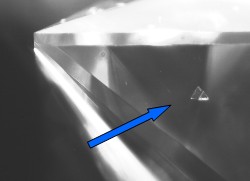 Trigons are one of the types of naturals (outer surface of rough diamond). Trigons are the triangular etch pits sometimes seen on the natural surfaces of a diamond that are sometimes visible even after the diamond has been cut and polished. The face of an octahedron (classic diamond crystal shape) is a triangle. Trigons found on octahedrons are oriented such that the point of its triangle is pointed in the opposite direction of point of the triangle of the octahedral face.
Trigons are one of the types of naturals (outer surface of rough diamond). Trigons are the triangular etch pits sometimes seen on the natural surfaces of a diamond that are sometimes visible even after the diamond has been cut and polished. The face of an octahedron (classic diamond crystal shape) is a triangle. Trigons found on octahedrons are oriented such that the point of its triangle is pointed in the opposite direction of point of the triangle of the octahedral face.
Similar etch markings include rectangles, squares, or parallel lines. A trigon sometimes looks like series of triangles within triangles. Typically, trigons are along or adjacent to the finished stone’s girdle but occasionally they are located on the facets. Trigons left on polished diamonds are generally too small to be visible to the eye but are fascinating characteristics when viewed through a microscope.
DE BEERS SPENDS TO GROW DEMAND
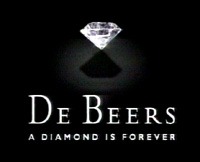 De Beers’ Diamond Trading Company (DTC) plans to increase media spending by 17 percent in 2006. The year 2005 marked the tenth consecutive year that diamond sales have increased and media advertising had much to do with that trend.
De Beers’ Diamond Trading Company (DTC) plans to increase media spending by 17 percent in 2006. The year 2005 marked the tenth consecutive year that diamond sales have increased and media advertising had much to do with that trend.
DTC, working with advertising agency J. Walter Thompson (JWT), will launch a new marketing campaign in the fall of 2006 called Journey Diamond Jewelry, a new gift of love. This campaign is based on the concept that love is a journey, it grows over time and through shared experiences and each couple has their unique story of a life built together.
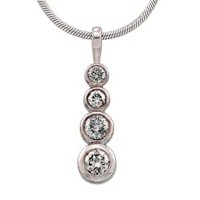 Journey Diamond Jewelry is defined as an item of jewelry that contains different-sized, graduated diamonds arranged from smallest to largest. Note, the pattern cannot be small to large and then back to small as is common in many necklaces today. There must be at least four stones and they can be any size but all must be diamonds.
Journey Diamond Jewelry is defined as an item of jewelry that contains different-sized, graduated diamonds arranged from smallest to largest. Note, the pattern cannot be small to large and then back to small as is common in many necklaces today. There must be at least four stones and they can be any size but all must be diamonds.
According to research done by JWT on Journey Diamond Jewelry, while only 45 percent of women found the prior “past, present, future” concept appealing, 71 percent found the journey concept appealing. The research showed that 59 percent of men also found the journey concept appealing.
Watch for print and television ads to start in September of 2006 and continue through the holidays.
GEMSTONES: ZIRCON
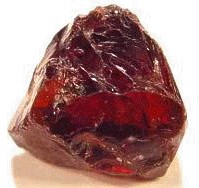 Zircon is a naturally occurring gemstone known for hundreds of years for its luster and fire. Because of its name, Zircon is sometimes confused with cubic zirconia (CZ), which is synthetic. This confusion is compounded by the fact that both Zircon and cubic zirconia have been used as diamond substitutes. Zircon has a high refractive index that produces its diamond like appearance and comes closer to resembling diamond than any other natural gem. Zircon can be distinguished from diamond because it is doubly refractive and because it is softer which results in wear and tear along facet edges.
Zircon is a naturally occurring gemstone known for hundreds of years for its luster and fire. Because of its name, Zircon is sometimes confused with cubic zirconia (CZ), which is synthetic. This confusion is compounded by the fact that both Zircon and cubic zirconia have been used as diamond substitutes. Zircon has a high refractive index that produces its diamond like appearance and comes closer to resembling diamond than any other natural gem. Zircon can be distinguished from diamond because it is doubly refractive and because it is softer which results in wear and tear along facet edges.
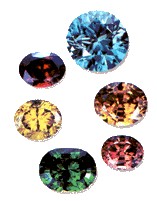 Zircon has colorless, yellow, orange, red, blue, brown and green varieties. Its color diversity results from traces of certain elements, some of which are radioactive. These radioactive forms of zircon must be heated to stabilize them for use as gems. In fact, almost all gem forms of zircon (even those that are not radioactive) are heat-treated to enhance their color. Heating semi-transparent, grayish-brown or reddish-brown zircons in an oxygen-free environment gives them a blue color. If these blue stones are then re-heated in air, their color returns to golden-brown.
Zircon has colorless, yellow, orange, red, blue, brown and green varieties. Its color diversity results from traces of certain elements, some of which are radioactive. These radioactive forms of zircon must be heated to stabilize them for use as gems. In fact, almost all gem forms of zircon (even those that are not radioactive) are heat-treated to enhance their color. Heating semi-transparent, grayish-brown or reddish-brown zircons in an oxygen-free environment gives them a blue color. If these blue stones are then re-heated in air, their color returns to golden-brown.
 All colors of Zircon are used as gems, but the colorless, golden-brown, and blue gems are the most popular. Colorless zircon is usually cut with the brilliant cut to optimize the stone’s fire.
All colors of Zircon are used as gems, but the colorless, golden-brown, and blue gems are the most popular. Colorless zircon is usually cut with the brilliant cut to optimize the stone’s fire.
Zircon is mined in Cambodia, Sri Lanka, Thailand, Myanmar, Australia, and other countries.
Zircon contains its own internal atomic clock. Its crystal accumulates atoms of uranium, which decay to lead at a known rate. By measuring the relative abundance of two types of uranium and lead in a zircon, geologists can determine old it is. A tiny fragment of zircon discovered in Western Australia is the oldest known object on earth: 4.404 billion years old. Earth itself formed less than 150 million years earlier. An even older example was discovered in a large meteorite in Chile. This zircon was the oldest thing scientists have ever examined. It was formed at least 4.6 billion years ago in the swirling disk of dust and rocks that became the planets.

